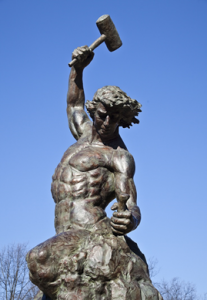In the book Outliers Malcolm Gladwell brings up the principal of 10,000 hours of practice to be a master. In the book Linchpin by Seth Godin describes the idea of being indispensable due to talent related to practice. In the book Mastery Roberte Greene helps define how it is certain people in history become masters. I think each are brilliant books and all demonstrates how with repetition people become better as they become more specialized at their craft. Slowly they whittle away at their task blowing away the chaff, chipping away imperfection and soon brilliance surfaces and even some times genius.
It is interesting to me in my past I worked at a factory out of high school. The factory made books and we would box and ship these books off to schools, and wherever. A machine would spit out books in a stack and we would have to open a box in a certain manner and envelop a paired stack of books in the box, then fold the ends over, flip the books and the box, then fold the top’s ends down and finally push the boxed books onto the conveyor belt for the taping machine to do it’s job. The hard part was learning the procedure when first hired on. You had to wait your turn behind a proficient boxer of books so not to mess up the machine. It was overwhelming to be expected to box books at the rate that the machine spit them out, but the experienced employee could do it effortlessly. The best way I can describe the way you box books is probably a lot like when you hit a wing chun dummy in a certain pattern. There was a feel and a cadence much like everything else it became easier with practice. After a year at the place and some heavy caffeination we would challenge our coworker on the opposite side of the machine to see who was the fastest at boxing books.
In the world of exercise there as always, are multiple upon multiple repeated tasks it reminds me of the karate kid and how the master taught the student how so many things that we do when paying attention to the subtle details have a purpose in a bigger picture. In exercise as you get better you feel positions you have trained over and over again, and their isometric ranges lock into position efficiently and often look effortless to the observer. On the jerk if mechanics are correct you can feel everything snap into position. In the clean you can feel the symmetry of the bar as you receive and your heels dig into the floor. In grappling each move and position that you have rehearsed are easily reprocessed and the feel of the position lock to a posture that is stable. In boxing there is the feel of the right contact in a well-executed combination of punches. In baseball the sweet spot on the bat or in tennis the feel of the perfect return. In basketball the feel of the ball leaving your fingertips and the certainty of it’s trajectory. All of these things are built in rehearsal and repetition. Each pattern is defined by a specific feel. This feel takes a long time for people to be aware of it without repetition.
It is interesting to me in my past I worked at a factory out of high school. The factory made books and we would box and ship these books off to schools, and wherever. A machine would spit out books in a stack and we would have to open a box in a certain manner and envelop a paired stack of books in the box, then fold the ends over, flip the books and the box, then fold the top’s ends down and finally push the boxed books onto the conveyor belt for the taping machine to do it’s job. The hard part was learning the procedure when first hired on. You had to wait your turn behind a proficient boxer of books so not to mess up the machine. It was overwhelming to be expected to box books at the rate that the machine spit them out, but the experienced employee could do it effortlessly. The best way I can describe the way you box books is probably a lot like when you hit a wing chun dummy in a certain pattern. There was a feel and a cadence much like everything else it became easier with practice. After a year at the place and some heavy caffeination we would challenge our coworker on the opposite side of the machine to see who was the fastest at boxing books.
All this being said each lift, posture and pattern can become drudgingly monotonous as you concentrate on getting a certain number of repetitions with a specific weight in order that you can make the gainz that you have planned. The problem is with reps often it is forgotten to feel. In the past I have explained how a bodybuilders focuses on the feel of the movement and it’s mechanics within the muscle though I think sometimes new people get used to the rep and less concerned about the feel of the position. When you get used to the feel you will notice the subtle pattern differences of each rep and the predisposition of some muscles to override the pattern due to fatigue. As you get to the end of your rep range.
Enter the use of Tempo. Tempo is probably not something that is needed for exercise though it is a variable of training that allows you to exploit the eccentric range of a lift with greater proficiency than on the concentric due to eccentric strength being superior to concentric. Isometric strength is also greater than concentric strength so it is another variable to utilize on the eccentric and sometimes the concentric. When and how to exploit these vairaibels of a rep involve pauseing with submaximal weight in the position you are weakest at on a lift. On the eccentric focusing on decelerating within the weakest range of motion is another way. Tempo is also a way to all a new client to not just look like a pneumatic oscillating machine that has no defined pattern. The basics of tempo are as follow 4 numbers define the speed of the lift.
51X2
The first number 5 defines the speed of the eccentric or negative when the agonist muscle group is lengthening
The second number 1 defines the pause or isometric at the least advantageous position on bench or deadlift at the bottom where you are weakest on pullup at the top when you are over the bar where you are weakest.
The third number X is the concentric or positive where you are accelerating the bar as fast as you can.
The fourth number is the 2 where you isometrically pause at the most advantageous position.
I believe Ian King is the originator of TEMPO feel free to correct me if I am wrong but he used 3 numbers to define the cadence. There are ways you can modify, or accentuate positions with a pause at varying locations. There is also the use of the isometric against a relatively immovable object to strengthen a sticking point. All that being said, I believe the tempo helps define the speed of the Kata that is an exercise. When you get good at a pattern you will know by feel of your symmetry, when your scapula is in the proper position, where your heal are what your neck is doing and over all, how technical the rep is. Until you pay attention to the subtlety of feel, or Fingerspitzengefühl (borrowed that from the book 48 Laws of Power) It will be hard to understand the Kata.


